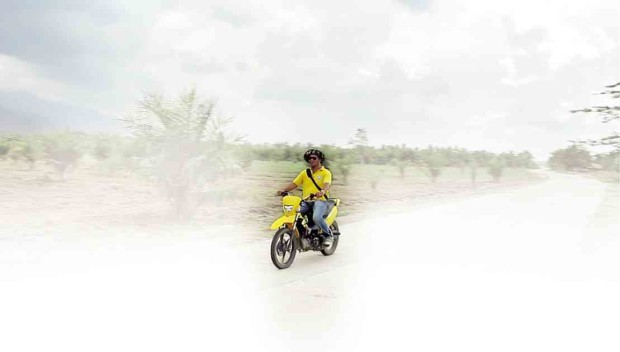Living in Isulan ‘budlay’ no more

TENG Andal traverses this once muddy and pockmarked farm road in Barangay Bual in Isulan, Sultan Kudarat, with ease after it has been concreted under the Philippine Rural Development Project. GIAN ENRIQUEL/CONTRIBUTOR
TENG Andal grew up in the village of Bual in this town seeing a vandalized sign that says “place of no return.”
Now 51 years old and a village councilor, Andal said he had witnessed the transformation of his once perilous place into a “zone of peace.”
Andal said living in the village in the past was a risky venture. Not because of armed clashes.
“Residents, especially farmers, refuse to live in this area because the road is unreliable,” Andal said.
“It was pockmarked and muddy that at one time, an engineer surveying the road got stuck waist-deep in the quicksand-like earth,” he said.
Article continues after this advertisementWhen the roads are clear, only carabaos with makeshift carriages, locally known as “karo,” can pass through, he said.
Article continues after this advertisementBudlay (Ilonggo for difficult) is what Andal and other residents, mostly Ilonggos and Maguindanaon, are quick to say when asked of the situation before.
“I have been a farmer here since 1976 but we had our farm in the other area (of the barangay) because it was difficult to transport our rice produce,” resident farmer Punsay Angeles said.
He said farmers would spend at least P30 in fee for hauling just to deliver their produce to the market.
For some, like Unsay Masla who is also a rice farmer and lives in the next barangay of Lagandang but passes through the same road, the cost is higher at P50.
“Before when there was no road there yet, we have to go around another route to take us to the junction where our produce can be transported to the market,” he said.
He said travel time had been reduced from 30 minutes to 15 minutes coming from the Bual FMR-provincial road junction to the town center, a distance of about 12 kilometers.
But with the concreting of a 1.4-km road section of the Bual-Talitay farm-to-market road (FMR) under the Department of Agriculture’s Philippine Rural Development Project (PRDP), residents said their travel woes had eased somehow.
Some farmers moved nearer their farms along the road. The FMR project costs P16 million.
“It has become convenient for us now. The hauling fee has been reduced to P10 to none at all, especially if delivery trucks would come to collect the produce themselves,” Angeles said.
Because of the concreted road, some farmers have also expanded production areas. “We have expanded our rice area from 3 to 4 hectares,” said Evangeline Cruz, whose rice farm is just near the concreted road section.
She added that residents and students have also enjoyed the benefits of the new road. “This has also helped our students here who would just walk to school before,” she said. “Now, motorcycles can fetch them,” she added.
Electricity in the area also came with the road project, according to Andal. Once the concreting of the road started, barangay officials lobbied for the electrification of that portion of the barangay.
“Now, we hope that other projects and development can enter this place,” he said.
The Bual-Talitay with two other FMR projects in Isulan, Sultan Kudarat (the 2-kilometer Tayugo-Paladong FMR and 1.8-kilometer Purok 2-San Martin FMR in two other barangays) are the first infrastructure projects that have been completed under PRDP and have been operational for a year.
“The FMR projects from PRDP really help a lot of farmers in our town with better income as transportation has been easier, faster and cheaper,” said Diosdado Pallasigue, a resident of Isulan.
He added that the PRDP FMR projects opened up an additional 1,000 ha of productive rice field.
Through its infrastructure component, PRDP aims to build efficient road networks that would link production areas to markets. PRDP is a World Bank-funded project with counterpart funding from the DA and local government units.
(Contributor Jay M. Rosas is the information and advocacy specialist of the Philippine Rural Development Project, a
P27.5-B World Bank project implemented by the Department of Agriculture, national government and local government units.)